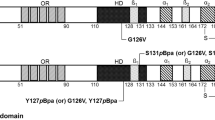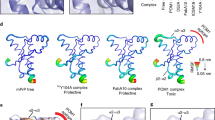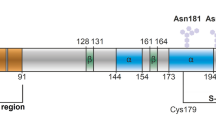Abstract
The normal cellular form of prion protein (PrPC) is a precursor to the pathogenic protease-resistant forms (PrPSc) believed to cause scrapie, bovine spongiform encephalopathy (BSE) and Creutzfeldt–Jakob disease1. Its amino terminus contains the octapeptide PHGGGWGQ, which is repeated four times and is among the best-preserved regions of mammalian PrPC. Here we show that the amino-terminal domain of PrPCexhibits five to six sites that bind copper (Cu(II)) presented as a glycine chelate. At neutral pH, binding occurs with positive cooperativity, with binding affinity compatible with estimates for extracellular, labile copper. Two lines of independently derived PrPCgene-ablated (Prnp0/0) mice exhibit severe reductions in the copper content of membrane-enriched brain extracts and similar reductions in synaptosomal and endosome-enriched subcellular fractions. Prnp0/0mice also have altered cellular phenotypes, including a reduction in the activity of copper/zinc superoxide dismutase and altered electrophysiological responses in the presence of excess copper. These findings indicate that PrPCcan exist in a Cu-metalloprotein form in vivo.
This is a preview of subscription content, access via your institution
Access options
Subscribe to this journal
Receive 51 print issues and online access
$199.00 per year
only $3.90 per issue
Buy this article
- Purchase on Springer Link
- Instant access to full article PDF
Prices may be subject to local taxes which are calculated during checkout



Similar content being viewed by others
References
Prusiner, S. B. Prion diseases and the BSE crisis. Science 278, 245–251 (1997).
Hornshaw, M. P., McDermott, J. R. & Candy, J. M. Copper binding to the N-terminal tandem repeat regions of mammalian and avian prion protein. Biochem. Biophys. Res. Commun. 207, 621–629 (1995).
Hornshaw, M. P., McDermott, J. R., Candy, J. M. & Lakey, J. H. Copper binding to the N-terminal tandem repeat region of mammalian and avian prion protein: Structural studies using synthetic peptides. Biochem. Biophys. Res. Commun. 214, 993–999 (1995).
Lau, S. J. & Sarkar, B. Ternary coordination complex between human serum albumin, copper (II) and L-histidine. J. Biol. Chem. 246, 5938–5943 (1971).
Scatchard, G. The attraction of proteins for small molecules and ions. Ann. NY Acad. Sci. 51, 660–567 (1949).
Giroux, E. & Schoun, J. Copper and zinc ion binding by bovine, dog and rat serum albumins. J. Inorg. Biochem. 14, 359–362 (1981).
Masuoka, J., Hegenauer, J., Van Dyke, B. R. & Saltmann, P. Intrinsic stoichiometric equilibrium constants for the binding of zinc(II) and copper(II) to the high affinity site of serum albumin. J. Biol. Chem. 268, 21533–21537 (1993).
Curzon, G. & Vallet, L. The purification of human caeruloplasmin. Biochem. J. 74, 279–287 (1960).
Manson, J. C. et al.129/Ola mice carrying a null mutation in PrP that abolishes mRNA production are developmentally normal. Mol. Neurobiol. 8, 121–127 (1994).
Stahl, N., Borchelt, D. R., Hsiao, K. & Prusiner, S. B. Scrapie prion protein contains a phosphatidylinositol glycolipid. Cell 51, 229–240 (1987).
Collinge, J. et al.Prion protein is necessary for normal synaptic function. Nature 370, 295–297 (1994).
Narahashi, T., Ma, J. Y., Arakawa, O., Reuveny, E. & Nakahiro, M. GABA receptor-channel complex as a target site of mercury, copper, zinc and lanthanides. Cell. Mol. Neurobiol. 14, 599–621 (1994).
Linder, M. C. Biochemistry of Copper (Plenum, New York, (1991)).
Hartter, D. E. & Barnea, A. Brain tissue accumulates 67copper by two ligand-dependent saturable processes. J. Biol. Chem. 263, 799–805 (1988).
Sarkar, B. & Wigfield, Y. Evidence for albumin-Cu(II)-amino acid ternary complex. Can. J. Biochem. 46, 601–607 (1968).
Neumann, P. Z. & Sass-Kortsak, A. The state of copper in human serum: evidence for an amino acid-bound fraction. J. Clin. Invest. 46, 646–658 (1967).
Martell, A. E. & Smith, R. M. Amino acids. in Critical Stability Constants (Plenum, New York, (1974)).
Brown, D. R., Schulz-Schaeffer, W. J., Schmidt, B. & Kretzschmar, H. A. Prion protein-deficient cells show altered response to oxidative stress due to decreased SOD-1 activity. Exp. Neurol. 146, 104–112 (1997).
Riek, R., Hornemann, S., Wider, G., Glockshuber, R. & Wüthrich, K. NMR characterization of the full-length recombinant murine prion protein, mPrP(23-231). FEBS Lett. 413, 282–386 (1997).
Miura, T., Hori-i, A. & Takeuchi, H. Metal-dependent α-helix formation promoted by the glycine-rich octapeptide region of prion protein. FEBS Lett. 396, 248–252 (1996).
Goldfarb, L. G. et al.Transmissible familial Creutzfeldt-Jakob disease associated with five, seven, and eight extra octapeptide coding repeats in the PRNP gene. Proc. Natl Acad. Sci. USA 88, 10926–10930 (1991).
Kretzschmar, H. A. et al.Molecular cloning of a human prion protein cDNA. DNA 5, 315–324 (1986).
Brown, D. R., Schmidt, B. & Kretzschmar, H. A. Role of microglia and host prion protein in neurotoxicity of prion protein fragment. Nature 380, 345–347 (1996).
Büeler, H. et al.Normal development and behaviour of mice lacking the neuronal cell-surface PrP protein. Nature 356, 577–582 (1992).
Nagy, A. & Delgado-Escueta, A. V. Rapid preparation of synaptosomes from mammalian brain using nontoxic isoosmotic gradient material (Percoll). J. Neurochem. 43, 1114–1123 (1984).
Soldati, T., Shapiro, A. D. & Pfeffer, S. R. Reconstitution of Rab9 endosomal targeting and nucleotide exchange using purified Rab9-GDP dissociation inhibitor complexes and endosome-enriched membranes. Meth. Enzymol. 257, 253–259 (1995).
Klockenkämper, R., Knoth, J., Prange, A. & Schwenke, H. Total-reflection X-ray fluorescence spectroscopy. Analyt. Chem. 64, 1115A–1121A (1992).
Acknowledgements
We thank C. Weissmann for providing Prnp0/0 mice; S. Prusiner and R. Race for antisera; H. Kijewski, S. Hampe and E. Jaikaran for assistance; and B. Sarkar, C. Huang and J. Masuoka for discussions. This study was supported by research grants for the University of Toronto Connaught New Staff Fund, the University of Toronto Dean'Fund, and the Alzheimer Association of Ontario to D.W., as well as the Bundesministerium für Bildung, Wissenschaft, Forschung und Technologie, the Wilhelm Sander-Stiftung, and the Deutsche Forschungsgemeinschaft to H.K.
Author information
Authors and Affiliations
Corresponding author
Rights and permissions
About this article
Cite this article
Brown, D., Qin, K., Herms, J. et al. The cellular prion protein binds copper in vivo. Nature 390, 684–687 (1997). https://doi.org/10.1038/37783
Received:
Accepted:
Published:
Issue Date:
DOI: https://doi.org/10.1038/37783
This article is cited by
-
Cellular toxicity of scrapie prions in prion diseases; a biochemical and molecular overview
Molecular Biology Reports (2023)
-
Peptide aptamer targeting Aβ–PrP–Fyn axis reduces Alzheimer’s disease pathologies in 5XFAD transgenic mouse model
Cellular and Molecular Life Sciences (2023)
-
Copper ions, prion protein and Aβ modulate Ca levels in central nervous system myelin in an NMDA receptor-dependent manner
Molecular Brain (2022)
-
Tumor Necrosis Factor α Reduces SNAP29 Dependent Autolysosome Formation to Increase Prion Protein Level and Promote Tumor Cell Migration
Virologica Sinica (2021)
Comments
By submitting a comment you agree to abide by our Terms and Community Guidelines. If you find something abusive or that does not comply with our terms or guidelines please flag it as inappropriate.



